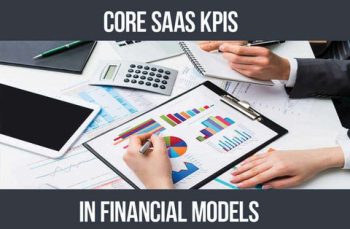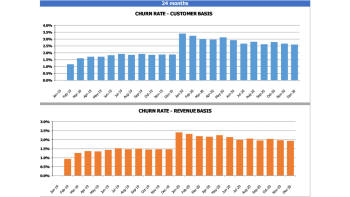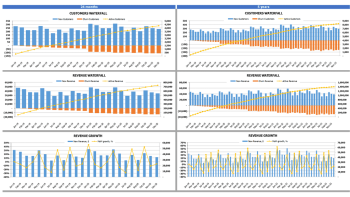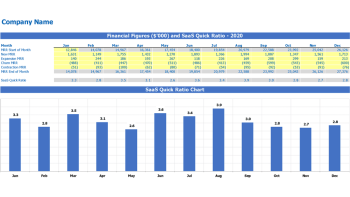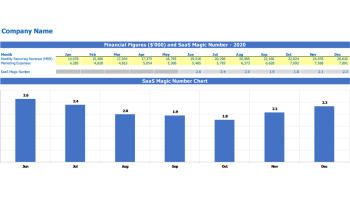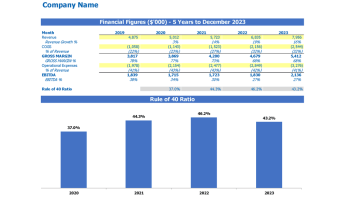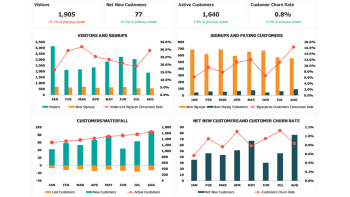Related Blogs
- Investing in bond funds – understanding the risks and getting the best returns
- Improve your CAC LTV ratio and unlock your business success with these tips!
- Unlock the Benefits of an Interim Profit Statement – Learn How!
- Address your tax lien today
- How to calculate and understand a balloon payment – take action today!
Every SaaS startup strives to track its own growth using SaaS Key Performance Indicators (SaaS Metrics) whenever possible. Additionally, with new companies popping up every day, there is a need to keep track of the progress of trade and market reforms. Although not always easy, this guide will provide you with Core SaaS KPIs required by any investor.
Nowadays, technology has advanced the business world, providing the entrepreneur with easier access to various information. For example, the advent of Software as a Service (SaaS), alongside Infrastructure as a Service (IAAS) and Platform as a Service (PAAS), has created a platform for financial companies. It achieves much more efficient transactions and flow of information. So, let’s dive deeper into some aspects of the SaaS business model and key metrics.
Download the Excel template! Learn even more ⟶
What is SaaS?
According to Wikipedia, software as a service is a cloud-based software service where a third-party partner can host applications and make them available to users on the web. Access could be on a subscription basis. So instead of customers having to purchase the software and install it on their computers, they can simply have easy access to it online.
Also, they can pay monthly for a subscription called Monthly Revenue or MRR. So, this is one of the SaaS strengths that can save a lot of time and effort for customers. Nowadays, SaaS can serve as a platform for various business organizations. It is one of the most popular business models and is in high demand among venture capitalists.
In today’s world, data analysis helps in proper estimation of financial results in business. Small scale or large scale businesses need to control how they operate based on the revenue generated each year. Therefore, a good financial analysis can be performed adequately using what are known as SaaS KPIs. Also, it can be called SaaS KPIs or sometimes SaaS metrics. A SaaS KPI measures how well a SaaS company is meeting its business goals. SaaS KPIs help all workers in a company or business to track their progress.
Plus, it helps them adjust the plan when needed. This is why SaaS businesses need specific SaaS KPIs to keep track of their growth and performance at all times. There are basic SaaS kpis in the financial models. This should be highlighted as they play a big role in good business performance reviews.
Core SaaS Metrics in SaaS Financial Models
To keep SaaS businesses stable and not distracted, let’s review basic SaaS metrics that can help track effectiveness.
Churn Rate – #1 kPI
Customer churn or turnover rate is an essential part of measuring the overall performance of any business. Churn refers to the measurement of customers who stop using your services or do not renew their subscription within a given period.
Churn rate provides an in-depth understanding of how and when customers interact with their products, allowing companies to reform their retention strategies. Once a customer leaves a business, a race to attract and retain new customers begins, which involves new investments and expenses.
Most companies use two types of churn, which are:
- Customer Churn Rate (Percentage of Lost Customers)
- Revenue Churn Rate (Percentage of Revenue Lost)
The Customer Churn Rate is good to track if you want to know how many customers you are losing each month. But if you want to know how much revenue you lose from customers who have stopped using your product, you go for revenue churn.
- How to calculate the churn rate?
The simplest formula for calculating customer churn is:
All businesses and SaaS businesses depend on long-term customer growth. The longer the customer continues with your business, the more you earn from them. Therefore, when your churn rate is above the recommended limit, it will start eating the company’s revenue to a point where the company is out of control.
It doesn’t matter how many new customers you acquire each month if you can’t stick with your old customers for a long time. In this scenario, you move in a circle and stay from where you started. This is why it is recommended to keep your churn rate as low as possible. Even if you have a 2% churn rate, you should keep looking for ways to make it as low as possible.
The 5% to 7% churn rate is considered “healthy” for most SaaS companies. However, if your churn rate is consistently above 10%, that indicates something is off and you should dive in to find what’s going on in your business.
For your convenience, FinModelslab has created a standalone spreadsheet, namely Churn Rate Formula Calculator , which helps you calculate your company’s monthly churn rate as follows:
Download the Excel template! Learn even more ⟶
Besides, it also shows the calculated churn rate in the graphical graph for quick and better understanding.
Monthly Recurring Revenue (MRR) – #2 kPI
Monthly recurring revenue, usually indicated by MRR, the revenue you collect from customers each month. As the name suggests, it should only include revenue that comes solely from recurring payments or subscriptions.
Download the Excel template! Learn even more ⟶
Usually, two categories fall under monthly recurring revenue:
- New MRR : MRR collected from new customers.
- MRR Extension : Collected from existing customers through subscription renewal or upgrade.
MRR is a volatile entity, and as you gain it you can also lose it and you need MRR for your business to operate. Monitoring the MRR helps you know the health of your business. It can be increased, decreased, or flat, reflecting the overall health and efficiency of your business.
Rising MRR is a good sign, and more revenue is coming in, which shows a grooming business. This means you capture new customers as well as old respect with you. It reflects excellent services as well as attractive incentives for new customers to enter.
The decrease in MRR is a sign that things are slowing down. If this happens for a month or two, it is normal, but decreasing MRR for long periods of time requires prompt action. You need to dig into your system and find out if the new MRR decreases or the MRR extension? Decreasing new MRR indicates your negligence towards capturing new customers, while declining MRR expansion reflects poor quality services that have shifted your customers to others.
The more you understand MRR, the more you can introduce new strategies to overcome the decrease in MRR. FinModelsLab is here to help you calculate MRR with its Recurring Revenue Calculator .
Download the Excel template! Learn even more ⟶
This recurring revenue waterfall template gives you a great way to visually show the SaaS revenue waterfall. All the required formulas are in place to create an automated waterfall chart based on changes in the Inputs tab. The Waterfall Tab offers three charts allowing you to analyze MRR inflows and outflows, new and lost customer trends in months.
Quick Ratio – #3 kPI
One of the important metrics for any SaaS business is the speed ratio. It assesses the company’s ability to increase recurring revenue despite being born. In short, the quick ratio compares the company’s input income and its output income to show the growth in net income. Thus, it is widely used as an efficiency indicator for the growth of a business.
Download the Excel template! Learn even more ⟶
The SaaS Rapid Ratio paints a better picture of business growth than any other metric, including MRR. The main reason is that it considers both the positive and negative sides of growing any business. Additionally, many pre-requisite investors for funding are providing quick ratio estimates. Therefore, due to its demand from investors, it has become the primary focus of industry professionals.
- How to calculate the quick ratio
These SaaS metrics can be calculated using the inflow and outflow of business revenue using the following formula:
A low rapid ratio indicates problems with sustainable revenue growth. This means that the additional revenue from the business restores lost revenue due to churn instead of growing the business.
The high rapid ratio indicates high and steady revenue growth for the company. This means that the additional income from the business covers the lost income, which means an efficient and growing business.
Usually, a quick ratio exceeding 4 is considered an indicator of a healthy and growing business with sustained high growth rates.
The FinmodelsLab SaaS Quick Ratio Calculator serves you best when calculating the quick ratio of your business.
Download the Excel template! Learn even more ⟶
For startups and early-stage companies, a SaaS Rapid Ratio of 4 or higher is considered healthy. However, at the same time, this ratio becomes more difficult to maintain as the business grows. Therefore, it will slowly decrease. For example, if the company has the fast SaaS ratio of 2, it may be a sign that it is losing around half of its monthly recurring revenue (MRR).
Magic Number – #4 KPI
A SaaS Company Magic Number Measures the company’s sales effectiveness. This shows how much it costs your business to grow, dividing revenue growth by the cost of expenses to drive that growth.
The magic number calculator is often used to assess the growth of a business. It only looks at revenue and cost of acquisition and ignores other important finances such as gross margins. But at the same time, they are useful and simple financial KPI measures.
Download the Excel template! Learn even more ⟶
If your Magic Number SaaS business is very low, for example, <0.5, you need to change your go-to-market model.
The magic ratio between zero and 0.5 normally shows that a business is growing very inefficiently and there is no sustainable growth model in place.
A magic number between 0.5 and 1 is an acceptable figure. It indicates that the company can stimulate new recurring revenue acquisition with affordable investments.
More than 1 is the ideal magic number. This means that the company has a capital-efficient growth model.
FinModelsLab has designed an Excel model to calculate the SaaS magic number that can help you estimate your business sales growth. Here is the template that magically creates the magic number for your business.
Customer Acquisition Cost (CAC) – #5 kPI
Customer Acquisition Cost (CAC) is the total amount you spend to get a new customer into your business. It helps to show precisely the expenses you will spend to gain new customers and the value a customer brings to a startup.
Download the Excel template! Learn even more ⟶
To calculate CAC, divide the cost to acquire customers, including advertising, salaries, and tools, by the total number of customers acquired.
CAC is an important SaaS metric that helps you determine how profitable your business is. For example, if you spend more to acquire a customer than their income, you lose your profits.
Increasing MRR doesn’t guarantee profitability if you don’t generate more money than you spend to acquire those customers. For simplicity, the customer lifetime value (LTV) must be greater than the customer acquisition cost LTV > CAC to ensure a profitable business.
Customer Lifetime Value (LTV) – #6 kPI
This KPI is an advanced way to see the productivity and efficiency of the SaaS business. Customer Lifetime Value (LTV) estimates how much revenue you will get from the average customer before they unsubscribe.
When you know how much a customer is worth, it sheds new light on acquisition. Note, this metric should never be less than the customer acquisition cost, because it means the startup is in trouble. It is therefore important to always keep this in mind.
Download the Excel template! Learn even more ⟶
- How to Calculate Lifetime Value
Customer lifetime value can be calculated using this simple formula:
One of the main reasons businesses use LTV is to determine how much they should spend to acquire a new customer. Ideally, LTV should be greater than CVC. A 3:1 LTV to CVC ratio is considered standard for most SaaS companies. If the CVC is higher than LTV, there are some ways to lower it for a profitable business.
What are you measuring SaaS KPIs?
That’s for sure: the SaaS business needs KPIs to keep track of business progress. It is therefore a very important parameter to record in business if an establishment wants to prosper.
There are other SaaS KPIs that FinModelslab offers to measure the health and profitability of your SaaS business. This includes:
Deferred Revenue Recognition Calculator
Download the Excel template! Learn even more ⟶
Deferred revenue is a payment your business receives from a customer for future products or services. Therefore, the company should also record this payment as a liability as it has not yet been earned.
SaaS revenue recognition and deferred revenue are important to implement for several important reasons. First, it is difficult for SaaS companies to assess financial performance using receipts for a reporting period.
Also, it’s impossible to see how your recurring revenue is growing. So, to properly calculate your SaaS business gross margin and recurring gross margin, you need to perform deferred revenue calculations. And without gross margins, it’s hard to steer your company’s financial performance or gauge the impact of new bookings or new staff. That’s why Deferred Income Calculator Car SaaS business is an essential financial planning tool.
Rule of 40
Download the Excel template! Learn even more ⟶
The Rule of 40 in SaaS is a simple financial framework that balances revenue growth against profit margins. It is an effective financial management tool that helps to quickly assess the health and attractiveness of a SaaS business.
According to the rule of 40, the recurring revenue growth rate of the top performing SaaS company plus EBITDA margin should be equal to or greater than 40%. It’s a simple and easy way to evaluate SaaS companies used by Brad Feld, a leading VC investor and founder of Techstars.
The goal of a good SaaS business is to have profit plus growth above 40%. If your business has met the Rule of 40 , you are considered attractive to investors.
FinModelsLab has created a SaaS Dashboard which helps SaaS startup in tracking basic SaaS metrics and polishing their businesses.
SaaS Dashboard
Download the Excel template! Learn even more ⟶
SaaS Dashboard Template Created in Excel spreadsheet format to help SaaS startups track basic SaaS metrics and polish their businesses. Instant download. Save your time, money and effort. No need to learn new software! This comprehensive set of SaaS metrics in an Excel template is all you need.
This SaaS Metrics Dashboard has over 30 SaaS operational metrics. You just need to enter a few indicators, and the rest of the KPIs are calculated on the fly – saving you more time to focus on business.
All SaaS metrics are divided into three categories: customer-related metrics (visitors and signups, new and lost customers, and more) SaaS metrics (monthly recurring revenue, annual recurring revenue, customer lifetime value, and more), cash and burn metrics (Cash in and Cash Out, Cash Rate, and more).
We have created many SaaS Financial Models ; Some of them are listed below.
- Average SaaS financial model
- Simple SaaS financial model
- Software development financial model
- Saas freemium financial model
- Data analysis financial model
- Actual SAASS financial model
- E-commerce financial model
- Finance and accounting financial model
- Procurements expenses and procurement of the financial model
- Customer relationship management financial model
- Financial model of customer service and engagement
- HR financial model
- Inventory Control Software Financial Model
Share with us what other SaaS KPI metrics you use, and if you have any questions, please don’t hesitate to contact us!
[right_ad_blog]

